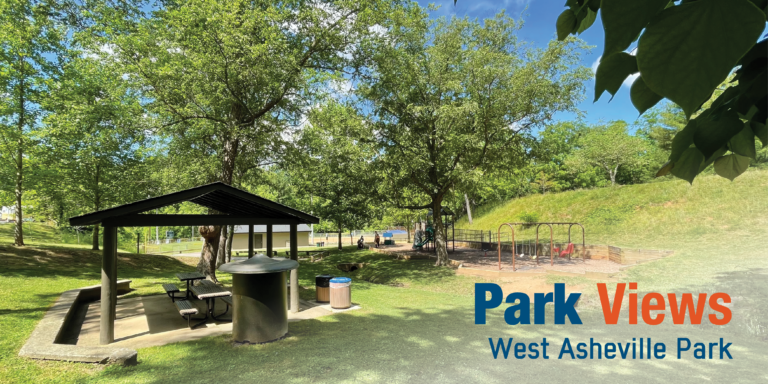This entry is part of Park Views, an Asheville Parks & Recreation series that explores the history of the city’s public parks and community centers – and the mountain spirit that helped make them the unique spaces they are today. Read more from the series.
West Asheville Park’s amenities sound simple – a ballfield, playground, creeks and wooded areas, two picnic shelters, and a garden. However, this neighborhood park plays an important role in youth development, neighborhood connections, and restoration of local waterways.
Other West Asheville Parks
When West Asheville voters elected to become part of Asheville in 1917, they looked forward to expanded city services like wider roads and public parks. City Council adopted a plan in 1920 that shows a green belt of parks around the city’s perimeter with a number of other public recreation spaces proposed in the recently annexed West Asheville.
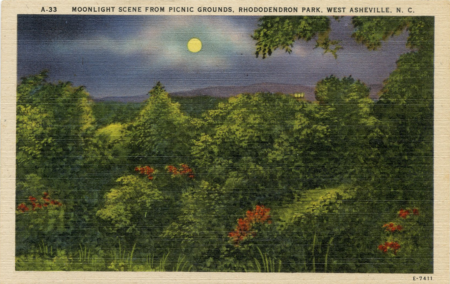 Horney Heights Park (now Malvern Hills Park) opened in 1921, followed ten years later by Roberts Park. Located near present-day Exit 1B on Interstate 240, Roberts Park is better remembered as Rhododendron Park, a 100-acre natural space and botanical garden overlooking the French Broad River with views of downtown Asheville, Biltmore, and surrounding mountain ranges. In 1941, an educational “tree school” was dedicated to public use with a collection of more than 150 native trees. It was dissected by the highway and sold at auction in 1967 to become Aston Park Healthcare Center’s new location.
Horney Heights Park (now Malvern Hills Park) opened in 1921, followed ten years later by Roberts Park. Located near present-day Exit 1B on Interstate 240, Roberts Park is better remembered as Rhododendron Park, a 100-acre natural space and botanical garden overlooking the French Broad River with views of downtown Asheville, Biltmore, and surrounding mountain ranges. In 1941, an educational “tree school” was dedicated to public use with a collection of more than 150 native trees. It was dissected by the highway and sold at auction in 1967 to become Aston Park Healthcare Center’s new location.
In 1953, West Asheville Community Center opened on Haywood Road. A neighborhood playground adjacent to the center is named Augusta Barnett Park in honor of Asheville Parks & Recreation (APR)’s first director.
Recognizing the need for more baseball and softball diamonds, YMCA of Western North Carolina opened Deaverview Park in the 1960s. APR entered into a partnership with the organization, leasing the sports fields for $1 a year before purchasing the park outright and eventually renaming it Roger Farmer Park.
Today, two West Asheville parks, Carrier and French Broad River, are among the most popular in the city. They’re connected by French Broad River Greenway on the west bank of the river with Amboy Riverfront Park between them.
Funding Parks
Asheville’s city park system was a mixed bag at the start of the 1970s. With Aston and Montford parks dating to the 1890s, the City of Asheville began providing recreation services in 1933 as the parks and playgrounds division under the Department of Public Works Department. In 1945, a year-round recreation program was instituted and APR became its own department in 1956.
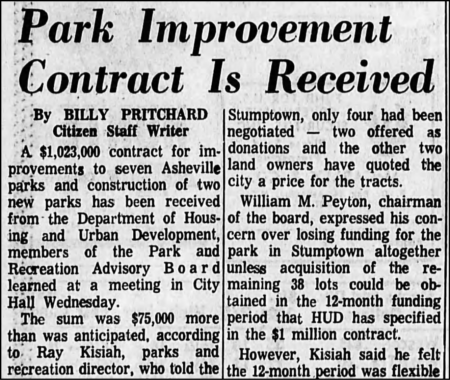 During Barnett’s tenure, new community centers and parks were developed, as well as accompanying programs for children, teens, and older adults. While she was successful in improving recreation programs, she did not have the luxury of quality facilities and the department was forced to use schools and other community organizations’ buildings to house activities during much of this time.
During Barnett’s tenure, new community centers and parks were developed, as well as accompanying programs for children, teens, and older adults. While she was successful in improving recreation programs, she did not have the luxury of quality facilities and the department was forced to use schools and other community organizations’ buildings to house activities during much of this time.
When she passed the reins to Ray L. Kisiah in 1971, APR experienced a decade of major expansion. The department’s small annual budget was paired with grants to leverage funding from federal programs collectively known as the Great Society designed to support local infrastructure and address the effects of poverty in urban areas.
As part of this planning, APR received $1,023,000 from the U.S. Department of Housing and Urban Development in 1973 for improvements at existing parks and construction of two new parks in West Asheville and Stumptown. Tennis courts at Weaver and Aston parks were constructed with these funds and lights added to ballfields in Walton Street and Weaver parks. The city’ Little League program was largely supported by ballfields at schools and diamonds at the two new parks would double ballfields in city parks from two to four.
West Asheville Park
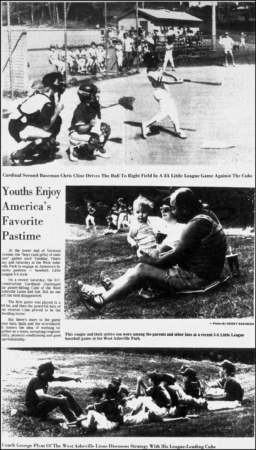 The initial parcel of land for West Asheville Park was acquired in 1974 with additional expansion in 1979. A 1975 City Council meeting brought residents opposed to development of a public park in their neighborhood, complaining that “hot rodders” and “persons meeting at night in the woods” would be better located away from their backyards.
The initial parcel of land for West Asheville Park was acquired in 1974 with additional expansion in 1979. A 1975 City Council meeting brought residents opposed to development of a public park in their neighborhood, complaining that “hot rodders” and “persons meeting at night in the woods” would be better located away from their backyards.
APR staff assured them that the new park was not intended as a replacement for Rhododendron Park, which was more than 10 times the size of the proposed park. West Asheville Park’s original layout included a ballfield, picnic shelter, playground, two tennis courts, shuffleboard courts, and a basketball court. The design utilized an existing right-of-way on Vermont Avenue for its primary parking lot; two small and unconnected parking lots on the south end of the park were designed to address the “hot rodding” concerns.
An existing single-family home was incorporated into the park. In exchange for serving as the park’s manager, individuals were given use of the house over the years in an agreement duplicated at Asheville Municipal Golf Course and Murphy-Oakley Park. Attendant’s duties included informing park users of rules, checking playground equipment, picking up litter, cleaning restrooms, and serving as ball field attendant.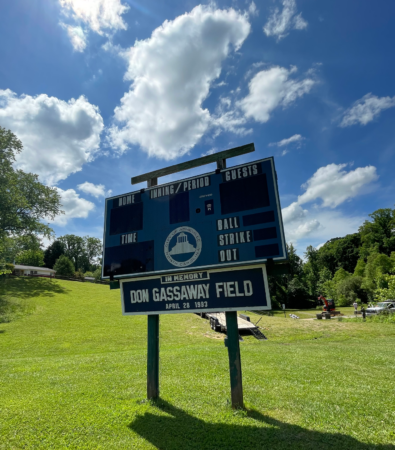
Tommy Gassaway was the final park manager to live in the house, serving from 1989-1996. When it sold in 1998 for $74,354, the proceeds were used to improve the playground and bring it into ADA compliance. In 1993, the ballfield was renamed Gassaway Field in honor of Don Gassaway, Tommy’s father who helped start West Asheville Little League. The house is now a private residence.
Center of Community
Upon opening, West Asheville Park served double duty as a neighborhood commons area and destination for community baseball and softball. Potlucks and parent meetups often took place in the picnic shelter and playground alongside skills clinics on the diamond. Easter egg hunts, tennis camps, and nature-oriented summer playground programs were common from the start. In 2009, the Samhain Public Witch Ritual celebrated its 15th anniversary in the park.
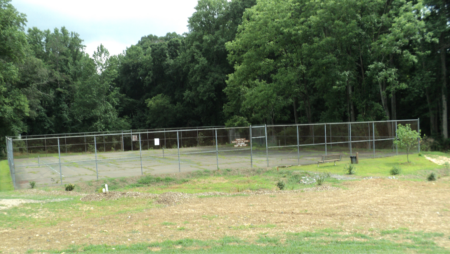 Tennis courts that were frequently damaged by floodwaters from two creeks running through the park were removed in the 2010s. To stabilize the streams and control erosion, RiverLink and Asheville GreenWorks restoration projects have added fruit trees and native plants and designed step-pool morphology to slow the flow of water towards Hominy Creek.
Tennis courts that were frequently damaged by floodwaters from two creeks running through the park were removed in the 2010s. To stabilize the streams and control erosion, RiverLink and Asheville GreenWorks restoration projects have added fruit trees and native plants and designed step-pool morphology to slow the flow of water towards Hominy Creek.
These two streams were unnamed for most of the park’s history. In 2007, the U.S. Board on Geographic Names granted use of Rhododendron Creek to identify the largest creek. It is named for Rhododendron Park, once located near the mouth of the stream. The other creek was named Orchard Creek in 2018 for a large apple orchard that was once located along the headwaters. Apartments at 87 Brevard Road housed orchard workers and a small house behind it used to be stables.
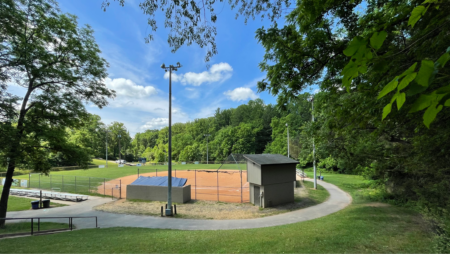 True to its intent, the park includes many of its original amenities, but has added an additional picnic shelter, replaced tennis courts with batting cages, and installed a streamside pollinator garden.
True to its intent, the park includes many of its original amenities, but has added an additional picnic shelter, replaced tennis courts with batting cages, and installed a streamside pollinator garden.
Do you have photos or stories to share about West Asheville Park? Please send them to cbubenik@ashevillenc.gov so APR can be inspired by the past as we plan our future. Sign up for APR’s monthly newsletter and follow APR on Facebook and Instagram for additional photos, upcoming events, and opportunities.
Photo and Image Credits
- West Asheville Park thrives on its connection to the neighborhood with spaces designed for congregation and reflection.
- Rhododendron Park stretched from the present location of Aston Park Healthcare Center to today’s Hominy Creek River Park. In addition to picnic areas and botanical gardens, it had ranges for shooting and archery, as well as a clubhouse. On this postcard (c. 1931-1945), Biltmore’s lit windows can be seen on the right. Courtesy of Buncombe County Special Collections, Pack Memorial Public Library, Asheville, North Carolina.
- Much of Asheville’s current park system is the result of talented grant writers and federal funding opportunities, a result of Kisiah’s strategy to shore up recreation spaces in the 1970s and 1980s.
- West Asheville Park may not house the largest diamond in the city, but it holds many memories for families and kids who grew up in Asheville.
- During West Asheville Little League’s 1993 season opener, the ballfield was dedicated to Don Gassaway. His wife, Gail, tossed the first pitch.
- Many neighborhood parks built or expanded on from 1970-1990 included a ballfield, basketball court, two tennis courts, playground, and picnic shelter as a standard blueprint. However, shifting public preference and natural elements have led to amenity changes at some parks. Batting cages have taken the place of West Asheville Park’s tennis courts. A pollinator garden is also located nearby.
- Gassaway Field remains the centerpiece of West Asheville Park with organized leagues, as well as kickball, lacrosse, ultimate frisbee, and other sports played between friends.
